沈阳版牛津英语8B英语导学案21 (1) 2
- 格式:doc
- 大小:33.00 KB
- 文档页数:2
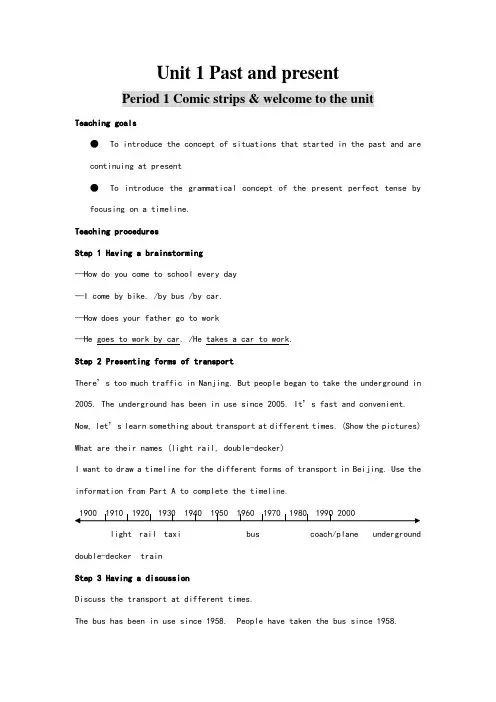
Unit 1 Past and presentPeriod 1 Comic strips & welcome to the unitTeaching goals●To introduce the concept of situations that started in the past and arecontinuing at present●To introduce the grammatical concept of the present perfect tense byfocusing on a timeline.Teaching proceduresStep 1 Having a brainstorming—How do you come to school every day—I come by bike. /by bus /by car.—How does your father go to work—He goes to work by car. /He takes a car to work.Step 2 Presenting forms of transportThere’s too much traffic in Nanjing. But people began to take the underground in 2005. The underground has been in use since 2005. It’s fast and convenient. Now, let’s learn something about transport at different times. (Show the pictures) What are their names (light rail, double-decker)I want to draw a timeline for the different forms of transport in Beijing. Use the information from Part A to complete the timeline.light rail taxi bus coach/plane underground double-decker trainStep 3 Having a discussionDiscuss the transport at different times.The bus has been in use since 1958. People have taken the bus since 1958.…Step 4 Listening to and reading a dialogueIn the past, people took the bus to work. But at present, more and more people can take the taxi /underground/double-decker car/ to work. The transport has changed a lot. What about our old friends Eddie and Hobo Have they changed a lotLet’s go on to listen to and read the dialogue on page 6 between Eddie and Hobo. Then answer the following questions:1. Where’s Hobo’s food Is it in the bowl now Why not (Because Eddie has eaten it.)2. Why has Eddie eaten his food (Because Eddie was hungry.)3. What did Hobo think of Eddie in the past (Hobo thought Eddie was kind in the past.)4. What does he think of Eddie now (Hobo thinks Eddie is bad now. So he doesn’t want to play with him any more.)5. Why does Eddie say that Hobo has changed a lot, too (Because Hobo wanted to play with him in the past, but now he doesn’t.)Step 5 Listening and reading aloudListen to the tape, and try to read aloud the dialogue on page 6 to the tape. Step 6 Finding and writing expressionsYou are to go over page 6 and 7 again to find out and write down all the useful expressions. Make sentences of your own with them after class.Step 7 Acting out the dialogueIn pairs act out the dialogue.Step 8 Doing homeworka. Read the comic strips and try to recite it.b. Try to revise the phrase and sentences in this period.c. Do translation:1. 我的玩具飞机在哪儿2. 你的妈妈怎样去上班乘坐地铁。
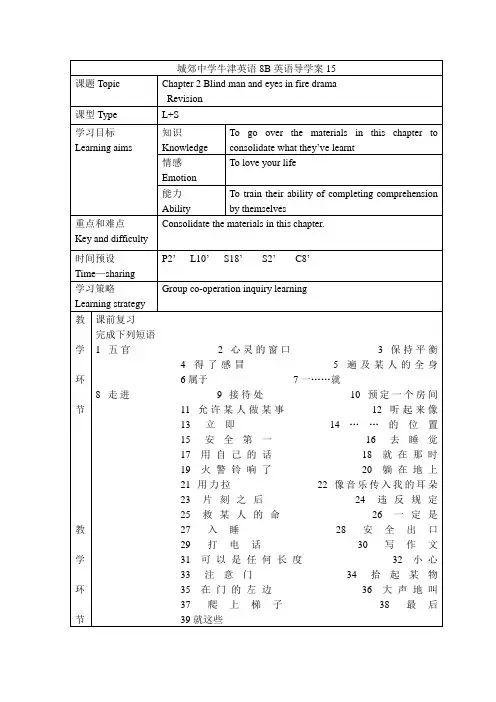
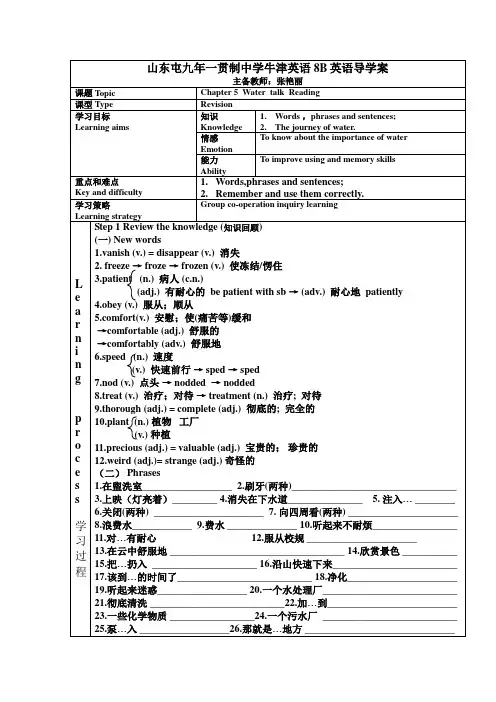
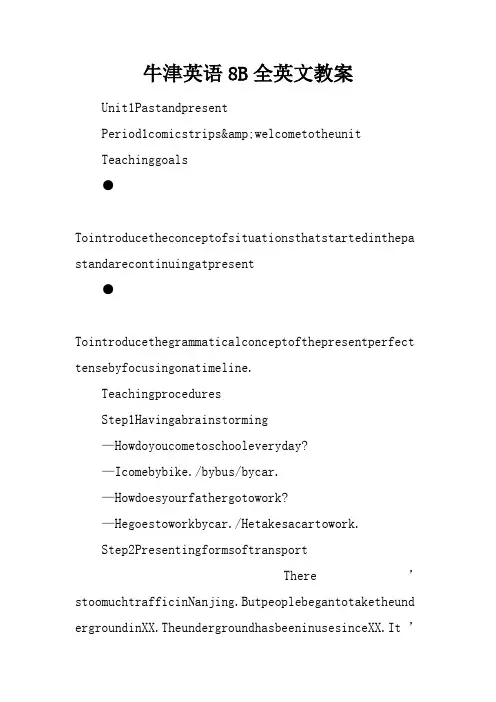
牛津英语8B全英文教案Unit1PastandpresentPeriod1comicstrips&welcometotheunitTeachinggoals●Tointroducetheconceptofsituationsthatstartedinthepa standarecontinuingatpresent●Tointroducethegrammaticalconceptofthepresentperfect tensebyfocusingonatimeline.TeachingproceduresStep1Havingabrainstorming—Howdoyoucometoschooleveryday?—Icomebybike./bybus/bycar.—Howdoesyourfathergotowork?—Hegoestoworkbycar./Hetakesacartowork.Step2PresentingformsoftransportThere’stoomuchtrafficinNanjing.Butpeoplebegantotaketheund ergroundinXX.TheundergroundhasbeeninusesinceXX.It’sfastandconvenient.Now,let’slearnsomethingabouttransportatdifferenttimes.whataretheirnames?Iwanttodrawatimelineforthedifferentformsoftransport etheinformationfromPartAtocompletetheti meline.900910920930940950960970980990XXlightrailtaxibuscoach/planeundergrounddouble-deckertrainStep3HavingadiscussionDiscussthetransportatdifferenttimes.Thebushasbeeninusesince1958.Peoplehavetakenthebussince1958.…Step4ListeningtoandreadingadialogueInthepast,peopletookthebustowork.Butatpresent,morea ndmorepeoplecantakethetaxi/underground/double-decke rcar/towork.Thetransporthaschangedalot.whataboutour oldfriendsEddieandHobo?Havetheychangedalot?Let’sgoontolistentoandreadthedialogueonpage6betweenEddi eandHobo.Thenanswerthefollowingquestions:.where’sHobo’sfood?Isitinthebowlnow?whynot?2.whyhasEddieeatenhisfood?3.whatdidHobothinkofEddieinthepast?4.whatdoeshethinkofEddienow?5.whydoesEddiesaythatHobohaschangedalot,too?Step5ListeningandreadingaloudListentothetape,andtrytoreadaloudthedialogueonpage6 tothetape.Step6Findingandwritingexpressionsyouaretogooverpage6and7againtofindoutandwritedownal ltheusefulexpressions.makesentencesofyourownwiththe mafterclass.Step7ActingoutthedialogueInpairsactoutthedialogue.Step8Doinghomeworka.Readthecomicstripsandtrytoreciteit.b.Trytorevisethephraseandsentencesinthisperiod.c.Dotranslation:.我的玩具飞机在哪儿?2.你的妈妈怎样去上班?乘坐地铁。
![沈阳版牛津英语八年级上学期导学案26[1]](https://uimg.taocdn.com/6a5b01d25022aaea998f0ffc.webp)
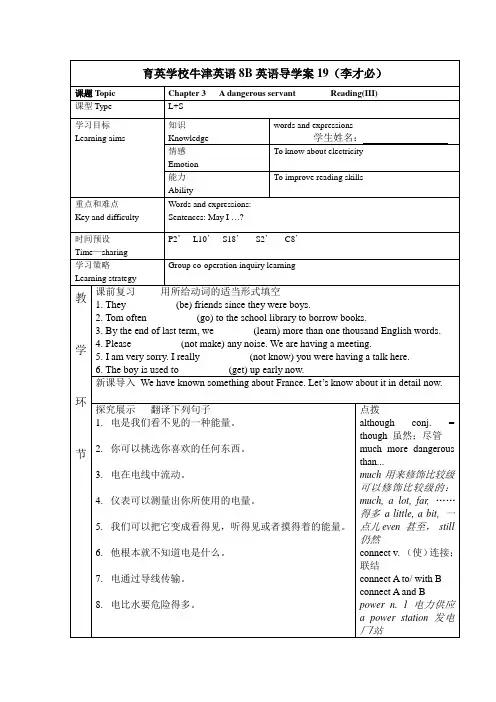
育英学校牛津英语8B英语导学案19(李才必)课题Topic Chapter 3 A dangerous servant Reading(III) 课型Type L+S学习目标Learning aims 知识Knowledgewords and expressions学生姓名:情感EmotionTo know about electricity能力AbilityTo improve reading skills重点和难点Key and difficulty Words and expressions: Sentences: May I …?时间预设Time—sharingP2’L10’S18’S2’C8’学习策略Learning strategyGroup co-operation inquiry learning教学环节课前复习用所给动词的适当形式填空1. They _________ (be) friends since they were boys.2. Tom often _________ (go) to the school library to borrow books.3. By the end of last term, we _______ (learn) more than one thousand English words.4. Please _________ (not make) any noise. We are having a meeting.5. I am very sorry. I really _________ (not know) you were having a talk here.6. The boy is used to _________ (get) up early now.新课导入We have known something about France. Let’s know about it in detail now.探究展示翻译下列句子1.电是我们看不见的一种能量。
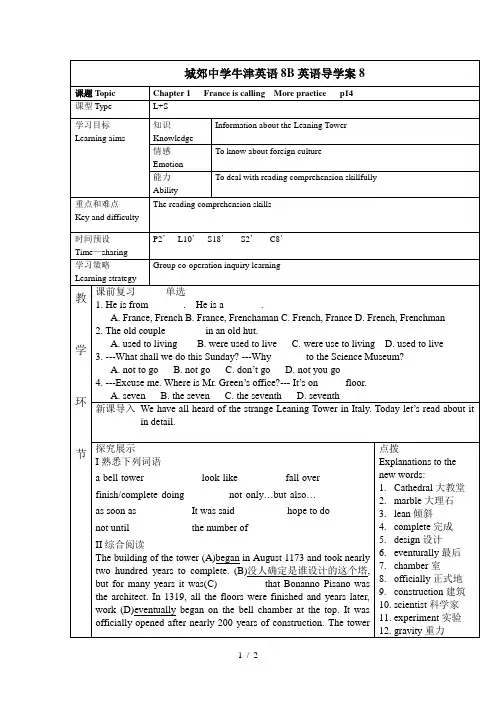
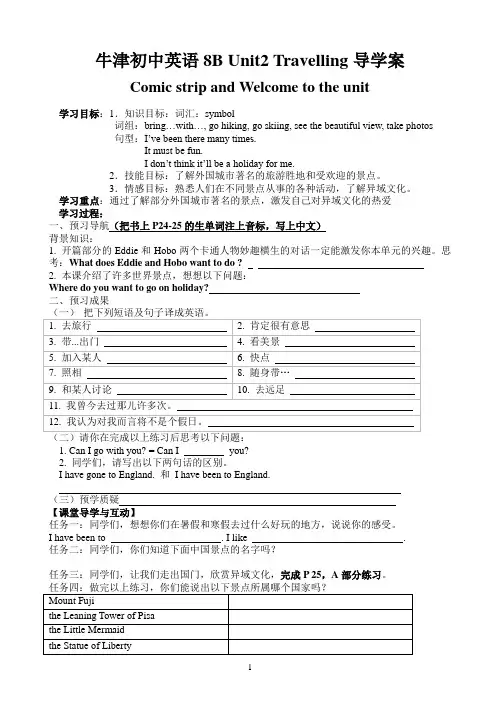
牛津初中英语8B Unit2 Travelling导学案Comic strip and Welcome to the unit学习目标:1.知识目标:词汇:symbol词组:bring…with…, go hiking, go skiing, see the beautiful view, take photos句型:I’ve been there many times.It must be fun.I don’t think it’ll be a holiday for me.2.技能目标:了解外国城市著名的旅游胜地和受欢迎的景点。
3.情感目标:熟悉人们在不同景点从事的各种活动,了解异域文化。
学习重点:通过了解部分外国城市著名的景点,激发自己对异域文化的热爱学习过程:一、预习导航(把书上P24-25的生单词注上音标,写上中文)背景知识:1. 开篇部分的Eddie和Hobo两个卡通人物妙趣横生的对话一定能激发你本单元的兴趣。
思考:What does Eddie and Hobo want to do ?2. 本课介绍了许多世界景点,想想以下问题:Where do you want to go on holiday?_______________ 二、预习成果1. Can I go with you? = Can I you?2. 同学们,请写出以下两句话的区别。
I have gone to England. 和I have been to England.(三)预学质疑______________【课堂导学与互动】任务一:同学们,想想你们在暑假和寒假去过什么好玩的地方,说说你的感受。
I have been to . I like .任务二:同学们,你们知道下面中国景点的名字吗?_____________________________________________________________任务三:同学们,让我们走出国门,欣赏异域文化,完成P 25,A部分练习。
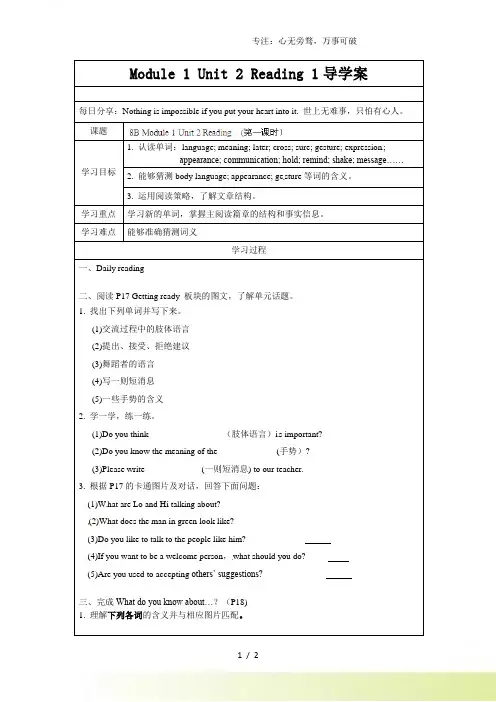
Module 1 Unit 2 Reading 1导学案每日分享:Nothing is impossible if you put your heart into it. 世上无难事,只怕有心人。
课题学习目标1. 认读单词:language; meaning; later; cross; sure; gesture; expression;appearance; communication; hold; remind; shake; message……2. 能够猜测body language; appearance; ge sture等词的含义。
3. 运用阅读策略,了解文章结构。
学习重点学习新的单词,掌握主阅读篇章的结构和事实信息。
学习难点能够准确猜测词义学习过程一、Daily reading二、阅读P17 Getting ready 板块的图文,了解单元话题。
1. 找出下列单词并写下来。
(1)交流过程中的肢体语言__________________________________(2)提出、接受、拒绝建议__________________________________(3)舞蹈者的语言__________________________________(4)写一则短消息__________________________________(5)一些手势的含义__________________________________2. 学一学,练一练。
(1)Do you think_________________(肢体语言)i s important?(2)Do you know the meaning of the_____________ (手势)?(3)Please write ____________ (一则短消息) to our teacher.3. 根据P17的卡通图片及对话,回答下面问题:(1)W hat are Lo and Hi talking about? _________________________________(2)What does the man in green look like? _________________________________(3)Do you like to talk to the people like him? _____________ ______________(4)If you want to be a welcome person,what should you do?_____ __________(5)Are you used to accepting others’ suggestions? ______________ __________三、完成What do you know about…?(P18)1. 理解下列各词的含义并与相应图片匹配。
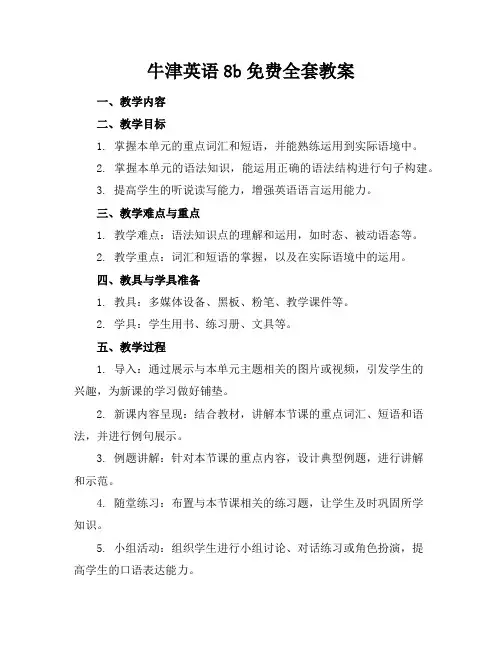
牛津英语8b免费全套教案一、教学内容二、教学目标1. 掌握本单元的重点词汇和短语,并能熟练运用到实际语境中。
2. 掌握本单元的语法知识,能运用正确的语法结构进行句子构建。
3. 提高学生的听说读写能力,增强英语语言运用能力。
三、教学难点与重点1. 教学难点:语法知识点的理解和运用,如时态、被动语态等。
2. 教学重点:词汇和短语的掌握,以及在实际语境中的运用。
四、教具与学具准备1. 教具:多媒体设备、黑板、粉笔、教学课件等。
2. 学具:学生用书、练习册、文具等。
五、教学过程1. 导入:通过展示与本单元主题相关的图片或视频,引发学生的兴趣,为新课的学习做好铺垫。
2. 新课内容呈现:结合教材,讲解本节课的重点词汇、短语和语法,并进行例句展示。
3. 例题讲解:针对本节课的重点内容,设计典型例题,进行讲解和示范。
4. 随堂练习:布置与本节课相关的练习题,让学生及时巩固所学知识。
5. 小组活动:组织学生进行小组讨论、对话练习或角色扮演,提高学生的口语表达能力。
六、板书设计1. Unit 1 Past and Present2. 重点词汇和短语:ancient, tradition, modern, technology, sport, cartoon等。
3. 语法结构:一般过去时、一般现在时、被动语态等。
七、作业设计1. 作业题目:(1)抄写本节课所学重点词汇和短语,每个单词写5遍。
① I ______ (use) the internet every day.② The Great Wall ______ (build) in ancient times.What's the main idea of Unit 1 Past and Present?2. 答案:(1)见板书。
(2)① use ② was built八、课后反思及拓展延伸1. 反思:本节课的教学效果如何?哪些环节需要改进?2. 拓展延伸:鼓励学生课后收集与新课相关的资料,如历史、文化、科技等方面的内容,以便在下一节课进行分享和讨论。
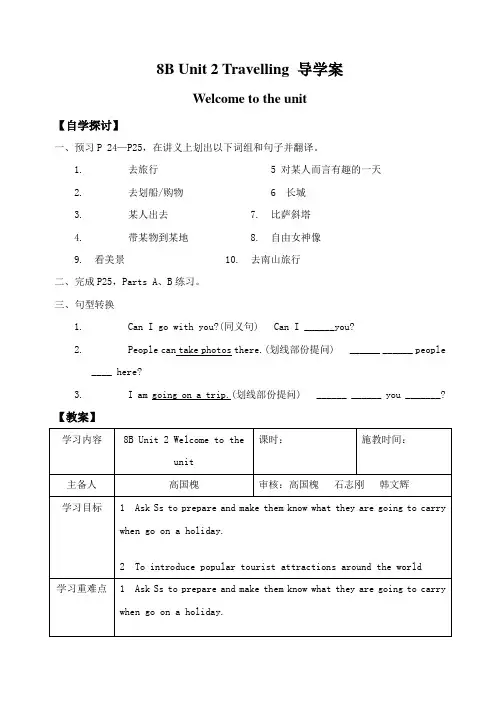
8B Unit 2 Travelling 导学案Welcome to the unit【自学探讨】一、预习P 24—P25,在讲义上划出以下词组和句子并翻译。
1.去旅行 5 对某人而言有趣的一天2.去划船/购物 6 长城3.某人出去 7. 比萨斜塔4.带某物到某地 8. 自由女神像9. 看美景 10. 去南山旅行二、完成P25,Parts A、B练习。
三、句型转换1.Can I go with you?(同义句) Can I ______you?2.People can take photos there.(划线部份提问) ______ ______ people____ here?3.I am going on a trip.(划线部份提问) ______ ______ you _______?【教案】【当堂巩固】一、单项选择题()1. Don’t look out ____ the window. You can’t see anything ______ it.A. from; fromB. of ; fromC. from ; ofD. of ; of()2. When you come next time, please______ your book here.A. bringB. takeC. fetchD. carry()3. I don’t think he is going with me, _______.A. do IB. don’t IC. is heD. is n’t he()4. He______be at home, because there is light in his room.B. can’tC. canD. might()5. I want you _______ so much noise.A. don’t makeB. not to makeC. to not makeD. not make()6. --- _____ are you going there?--- On foot.A. WhereB. WhyC. HowD. What() Do you like______ ?--- Yes, very much.A. go fishingB. going fishingC. going fishD. going to fish()8. He was_____ excited _____ he forgot to take the bag.A. too, toB. such, thatC. so, thatD. too,that() I don’t know what to do?--- Why not _______ ?A. To join usB. to join in usC. join usD.join with us() new book_______ very interesting.A. beB. maybeC. can’tD. must beReading【自学探讨】1.跟磁带朗诵第课文,可要注意语音语调。
育英学校牛津英语8B英语导学案20(李才必)课题T opic Chapter 3 A dangerous servant Listening课型Type L+S学习目标Learning aims 知识KnowledgeListening comprehension; pronunciation and intonation情感EmotionTo learn about electricity学生姓名:能力AbilityTo improve listening skills重点和难点Key and difficulty Words: flat,machine, usual, fridge, vacuum, iron, kettle, cause, properly, check Expressions: go off, deal with, find out, a rice cooker, a vacuum cleaner….时间预设Time—sharingP2’L10’S18’S2’C8’学习策略Learning strategyGroup co-operation inquiry learning教学环节课前复习写出下列内容的同义词或短语1.after a long time_________ _________2.words that make something clear _________ _________3.that cannpt be seen_________4.kinds_________5.joined_________6.every month_________7.put under the ground_________8.partly_________ _________ _________9.the power to do things_________新课导入We have known something about France. Let’s know about it in detail now.探究展示I. 熟悉下列单词flat______ machine_________ usual__________ fridge_______vacuum________ iron________ kettle________ cause________properly__________ check_________ electrician___________II熟悉下列短语1. go off________2. deal with_________3. find out________4. an air conditioner________5. a washing machine_________6. a rice cooker__________7. a kettle_____________8. a vacuum cleaner____________ 9. an iron____________III.完成书上第34页的听力题。
词短语等 (7). 由某些表示过去时态的从句等。
如when+过去式句子(When he was 10 years old; When I saw her)等等。
5. 句子结构: 肯定句:主语+动词过去式(+其他) 否定句:主语+didn ’t+动词原形(+其他) 一般疑问句:Did+主语+动词原形(+其他)? 特殊疑问句:疑问词+did+主语+动词原形(+其他)? 注:疑问词作主语时:疑问词+动词过去式(+其他)? 二、anyone else = anybody else = any other people 其他任何人 else 用于复合不定代词和疑问词后 点拨 一、一般过去时 1. 概念:(1)过去某个时间发生的动作或存在的状态。
(2)过去的习惯,过去经常、反复发生的动作。
(3) 表示已故人所做的事情。
2. 构成:谓语动词用动词的过去式(没有人称和数的变化)。
3. 动词过去式的变化规则: be 动词的过去式为was 和were 两个,行为动词的过去式,其变化分为规则和不规则的两种。
(1) 规则动词 A :一般动词原形末尾加-ed 。
如:look →looked, stay →stayed ; B : 以e 结尾的动词只加-d 。
如:hope →hoped, live →lived; C : 末尾只有一个辅音字母结尾的重读闭音节的动词,应先双写这个辅音字母,再加-ed.如:stop →stopped, plan(计划) →planned; D :结尾是“辅音字母+y”的动词,先将y 改为i,再加-ed. 如:study →studied, carry →carried. (2) 不规则动词(111型,121,122型,和123型) 4. 常用的状语:一般来说,一般过去时都有明显的时间状语,它们可以是单词,也可以是短语或从句。
(1). the day before yesterday, yesterday 或以其构成的短语:yesterday morning(afternoon, evening)等; (2). 由“last+一时间名词”构成的短语:last night, last year (winter, month, week, century, Monday)等; (3). 由“时间段+ago”构成的短语:a moment ago, a short time ago, an hour ago 等; (4). 由“介词+一时间名词”构成的短语:on Friday, on Monday morning, on April 15, on the night of Oct. 1; 5.频度副词:often, always, sometimes 等; (6). 其它:then, just now, once,以及由after 或before 构成的介词短语等 (7). 由某些表示过去时态的从句等。
初中牛津英语8b全部教案初中牛津英语8b全部教案1一、语言知识与技能1.根据读音规则和音标拼读单词。
2.理解和领悟词语的基本含义、语法项目以及语言形式的基本结构和常用表意功能;3.能在日常交际情景中听懂对话,例如,能听懂连续的指令并据此完成任务;能引出话题并进行几个回合的交谈;4.能听懂接近正常语速、熟悉话题的语段和简单故事,获取相关信息;5.能运用…..词汇和…..语言形式就熟悉的话题进行交谈;能运用…..词汇和…..语言形式及(或)所给提示描述人、物、事件、行为、特征等,表达简单的观点;6.能在教师的指导下进行简单的角色表演;7.能连贯、流畅地朗读课文;能从简单的*中找出有关信息,理解大意;根据上下文猜测生词的意思;8.每天课外阅读量最少达到100词。
9.能运用…..词汇和…..语言形式以及参照范例(*结构)写出简单的文段等,包括起草和修改。
二、文化意识10.了解语言和语用的文化因素,体验跨文化交际。
三、学习策略11-(1)利用读音规则和音标拼读词汇,利用上下文、非语言信息等理解词义,联想学习和记忆词汇,构词法等。
11-(2)利用情境等理解语法结构和表意功能,发现语言规律并举一反三。
11-(3)复习、整理归纳所学内容。
11-(4)利用预测、语调、重音、问题等来获取听力信息。
11-(5)在课内外活动中借助体态语用英语交流。
11-(6)利用预测、跳读、寻读、细节读等来获取*信息。
11-(7)仿写短文,准备素材、起草短文并修改。
11-(8)明确目标,制定计划,11-(9)了解并跨文化交际(恰当使用)。
四、情感态度12.乐于参与英语活动,敢于用英语表达,积极与他人合作,体验自己的学习效果。
备教学重、难点内容课标具体知识、技能、文化目标知识与技能、文化意识的重、难点内容课标具体策略目标选择sectionAsectionB目标1在读写过程中,能够根据读音规则和音标拼读单词。
11-(1)11-(2)11-(3)目标2词汇:name,nice,to,meet,too,your,Ms.,his,and,her,yes,she,he,no,not.语言形式:1)what’syourname?---Alan./I’mAlan./Myname’sAlan.2)Nicetomeetyou.3)What’shisname?---He’sEric./Hisname’sEric.4)What’shername?---She’sMary./Hername’sMary.5)IsheJack?---Yes,h eis./No,heisn’t.Hisname’sMike.6)AreyouHelen?---Yes,Iam./No,I’mnot.I’mGina.词汇:zero,one,two,three,four,five,six,seven,eight,nine,telephone,number ,phone,telephone/phonenumber,first,firstname,last,lastname,frien d,China,middle,school,middleschool.语言形式:1)What’syourphonenumber?---It’s…/Myphonenumberis…2)Isthisyourphonenumber?---Yes,itis./No,itisn’t.3)What’syourfirst/given/last/familyname?---Myfirst/given/last/fami lyname’s…初中牛津英语8b全部教案2一、总体目标1、加强课堂教学改革,真正转变课堂教学方式,提高学生的学习能力,争取把课堂变成学生学习的乐园。
牛津英语8B Unit2 TravellingSpeak up and Study skills导学案【学习导航】◆学习目标◆学习重难点1.学会使用5个要点描述一次经历或一件事。
2.学会使用细节来丰富文章。
【课前自学】预习P30-31,1.搭乘直飞航班______________________________2.顺便问一下__________________3.出差_________________________4.五一假期_________________5.要点________________6.Do you have any plans for the May Day holiday?_______________________________________7.By the way, how long does it take to fly to Chengdu?_____________________________________二、和你的搭档读一读Speak up 并模仿语音语调,回答以下问题:1.Who will Amy go to Chengdu with ?______________________________2.Why has Simon’s dad been to Chengdu twice ?_______________________3.How will Amy go to Chengdu ?___________________________________4.How long does it take to fly to Chengdu?____________________________三、Do you still remember Kitty’s trip to HongKong Disneyland?When Where Who What How 根据5个要点复述Kitty的旅行。